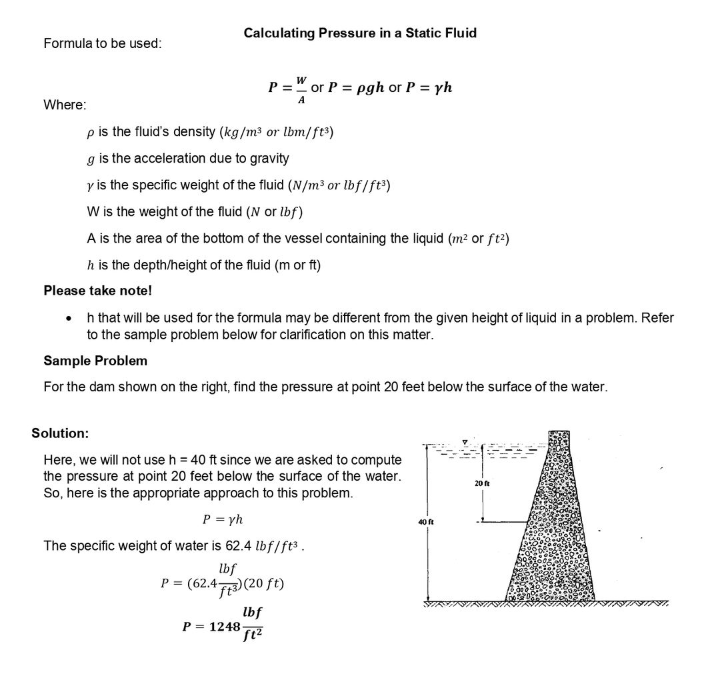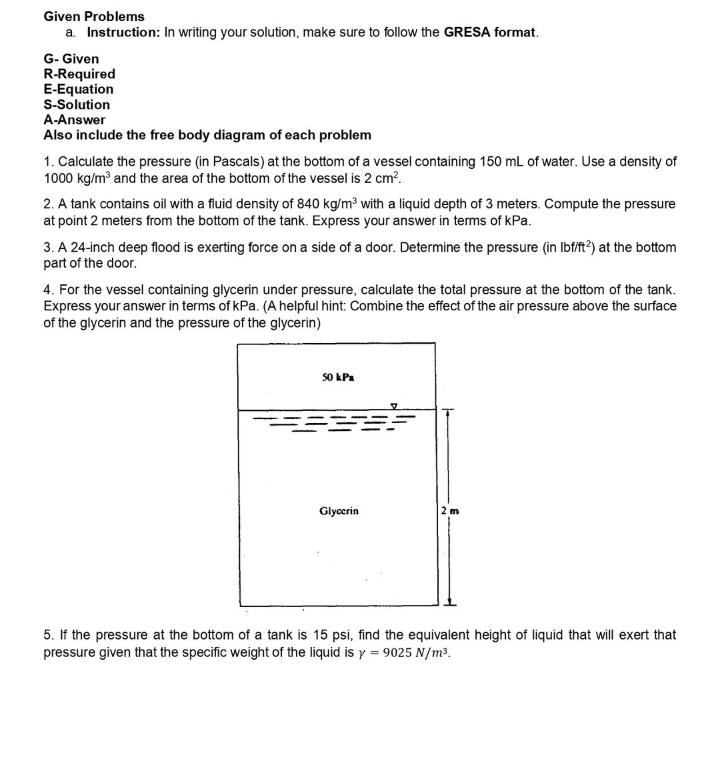Given Problems a. Instruction: In writing your solution, make sure to follow the GRESA format. G- Given R-Required E-Equation S-Solution A-Answer Also include the free body diagram of each problem 1. Calculate the pressure (in Pascals) at the bottom of a vessel containing 150 mL of water. Use a density of 1000 kg/m³ and the area of the bottom of the vessel is 2 cm². 2. A tank contains oil with a fluid density of 840 kg/m³ with a liquid depth of 3 meters. Compute the pressure at point 2 meters from the bottom of the tank. Express your answer in terms of kPa. 3. A 24-inch deep flood is exerting force on a side of a door. Determine the pressure (in lbf/ft²) at the bottom part of the door.
Given Problems a. Instruction: In writing your solution, make sure to follow the GRESA format. G- Given R-Required E-Equation S-Solution A-Answer Also include the free body diagram of each problem 1. Calculate the pressure (in Pascals) at the bottom of a vessel containing 150 mL of water. Use a density of 1000 kg/m³ and the area of the bottom of the vessel is 2 cm². 2. A tank contains oil with a fluid density of 840 kg/m³ with a liquid depth of 3 meters. Compute the pressure at point 2 meters from the bottom of the tank. Express your answer in terms of kPa. 3. A 24-inch deep flood is exerting force on a side of a door. Determine the pressure (in lbf/ft²) at the bottom part of the door.
Automotive Technology: A Systems Approach (MindTap Course List)
6th Edition
ISBN:9781133612315
Author:Jack Erjavec, Rob Thompson
Publisher:Jack Erjavec, Rob Thompson
Chapter44: Four- And All-wheel Drive
Section: Chapter Questions
Problem 7RQ: When the plates of a viscous coupling (clutch) rotate at different speeds, the plates ____________...
Related questions
Topic Video
Question

Transcribed Image Text:Formula to be used:
Where:
Please take note!
Calculating Pressure in a Static Fluid
or P = pgh or P = yh
p is the fluid's density (kg/m³ or lbm/ft³)
g is the acceleration due to gravity
y is the specific weight of the fluid (N/m³ or lbf/ft³)
W is the weight of the fluid (N or lbf)
A is the area of the bottom of the vessel containing the liquid (m² or ft²)
h is the depth/height of the fluid (m or ft)
P =
P = 1248
h that will be used for the formula may be different from the given height of liquid in a problem. Refer
to the sample problem below for clarification on this matter.
Sample Problem
For the dam shown on the right, find the pressure at point 20 feet below the surface of the water.
Solution:
Here, we will not use h = 40 ft since we are asked to compute
the pressure at point 20 feet below the surface of the water.
So, here is the appropriate approach to this problem.
P = yh
The specific weight of water is 62.4 lbf/ft³.
lbf
P = (62.4 ft3) (20 ft)
lbf
ft²
40 ft
20 ft

Transcribed Image Text:Given Problems
a. Instruction: In writing your solution, make sure to follow the GRESA format.
G- Given
R-Required
E-Equation
S-Solution
A-Answer
Also include the free body diagram of each problem
1. Calculate the pressure (in Pascals) at the bottom of a vessel containing 150 mL of water. Use a density of
1000 kg/m³ and the area of the bottom of the vessel is 2 cm².
2. A tank contains oil with a fluid density of 840 kg/m³ with a liquid depth of 3 meters. Compute the pressure
at point 2 meters from the bottom of the tank. Express your answer in terms of kPa.
3. A 24-inch deep flood is exerting force on a side of a door. Determine the pressure (in lbf/ft²) at the bottom
part of the door.
4. For the vessel containing glycerin under pressure, calculate the total pressure at the bottom of the tank.
Express your answer in terms of kPa. (A helpful hint: Combine the effect of the air pressure above the surface
of the glycerin and the pressure of the glycerin)
50 kPa
Glycerin
2 m
5. If the pressure at the bottom of a tank is 15 psi, find the equivalent height of liquid that will exert that
pressure given that the specific weight of the liquid is y = 9025 N/m³.
Expert Solution
This question has been solved!
Explore an expertly crafted, step-by-step solution for a thorough understanding of key concepts.
Step by step
Solved in 4 steps with 4 images

Knowledge Booster
Learn more about
Need a deep-dive on the concept behind this application? Look no further. Learn more about this topic, mechanical-engineering and related others by exploring similar questions and additional content below.Recommended textbooks for you

Automotive Technology: A Systems Approach (MindTa…
Mechanical Engineering
ISBN:
9781133612315
Author:
Jack Erjavec, Rob Thompson
Publisher:
Cengage Learning

Refrigeration and Air Conditioning Technology (Mi…
Mechanical Engineering
ISBN:
9781305578296
Author:
John Tomczyk, Eugene Silberstein, Bill Whitman, Bill Johnson
Publisher:
Cengage Learning

Automotive Technology: A Systems Approach (MindTa…
Mechanical Engineering
ISBN:
9781133612315
Author:
Jack Erjavec, Rob Thompson
Publisher:
Cengage Learning

Refrigeration and Air Conditioning Technology (Mi…
Mechanical Engineering
ISBN:
9781305578296
Author:
John Tomczyk, Eugene Silberstein, Bill Whitman, Bill Johnson
Publisher:
Cengage Learning